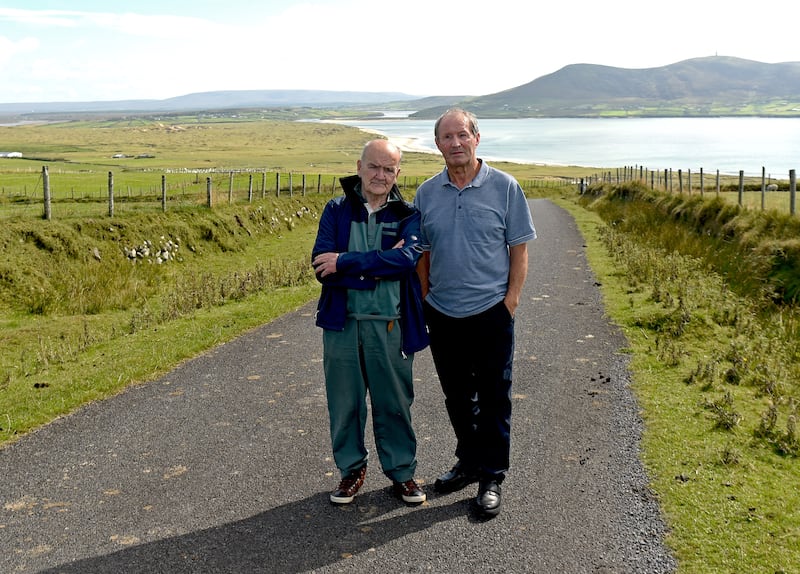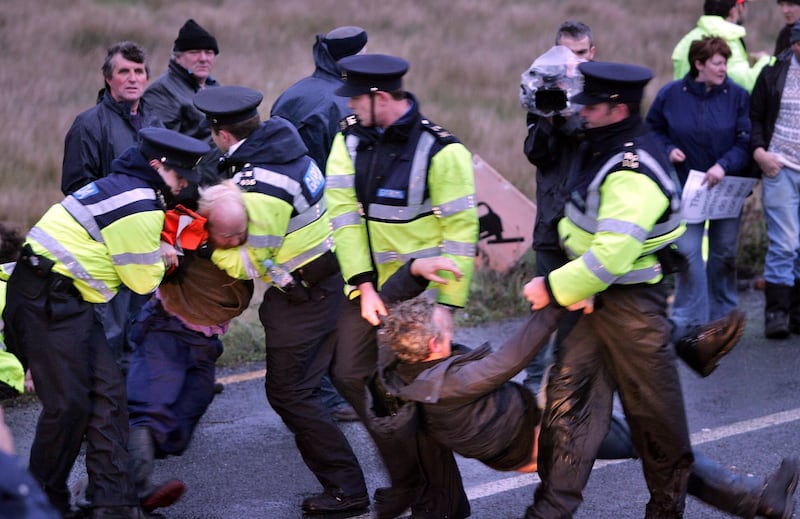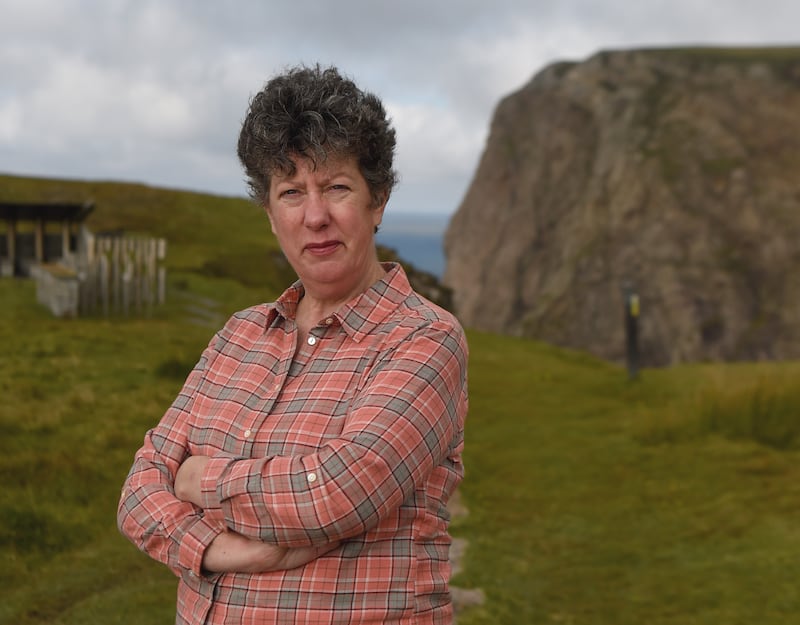Surrounded by trees planted by Coillte, the Bellanaboy Bridge gas terminal near Ballina in Co Mayo has gradually become part of the landscape, with all traces of the protests that marked its creation now gone.
For almost a decade now, the plant has brought the fruits from the Corrib gas field on shore and if its owners, Vermilion and Nephin Energy, are successful in proposals to extend its lifespan by using it to harness renewable energy, it could yet become Ireland’s main energy hub.
That is very good news for local man Brendan Lynch, who has been involved with the Corrib Gas project since 2009 when Shell was still the lead partner. Today, he is one of the plant’s 130 employees, the majority of them locals.
“The employees here are very excited and interested about the possibilities of extending the life of the Corrib facility as part of the energy transmission in Ireland,” says Lynch.
READ MORE
Extraction from the gas field 80km out in the Atlantic that supplies the plant is due to wind down in the early 2030s, but Vermilion and Nephin Energy are investigating using Bellanaboy to process offshore wind energy and possibly green hydrogen.
Such a move would significantly extend Ireland’s native energy supplies securely and safely for “decades to come”, they said in a statement to The Irish Times.
Consultation with locals and other stakeholders – which was at the heart of much of the difficulties in the period after the field was discovered off the north Mayo coast by Enterprise Energy Ireland in 1996 – has been promised.
Ultimately, the gas field cost €3.6 billion to develop and the gas did not begin to flow until December 2015 as a result of its development being held up by various An Bord Pleanála hearings and local resistance that resulted in the jailing of five local men amid protests on land and sea.
‘Fishermen cannot be pushed off traditional grounds where they have fished for hundreds of years so big companies can build infrastructure and make profits’
Welcome jobs
“Vermilion’s approach is to proactively communicate with local and Government stakeholders to provide information on our activities and invite feedback,” it says.
The jobs, it knows, would be welcome. For Lynch and other locals, many of whom are in managerial roles, emigration had traditionally been the default option.
“I grew up in Belmullet and always felt privileged to live in such a beautiful place. When I went off to college in Galway I always thought that I would be working away from home but instead I was able to return and start a family here,” he says.
Today, like many others, he feels lucky to have a good work-life balance, with a short commute to work and a pristine natural environment for all sorts of outdoor pursuits.

“There are so many opportunities to be involved in such local organisations as the GAA. We are the same people who are on the sidelines for matches supporting the local clubs,” he says.
Workers feel an “an enormous sense of pride”, he says, that Corrib has exceeded expectations with regard to reliability and performance. It also claims one of the lowest greenhouse gas emissions records of any plant of its type.
Eamon Dixon represents the skippers and crew of over 60 inshore fishermen from Belderrig to Dohooma along the rugged Erris coastline and so takes what he regards as a pragmatic approach to the Vermilion proposals.
As secretary of Erris Inshore Fishermen’s Association (Eifa), Dixon says: “If there are to be developments with renewables, such as wind and green hydrogen, Vermilion must first look at the level of fishing activity in the area.”
Successful negotiation
In 2008, Eifa successfully negotiated with Shell to ditch a plan to locate an outfall pipe, disposing of treated produced water from unrefined gas, in their fishing grounds.
“They must keep in mind that most of our fishing is carried out within 12 miles offshore and that our gear – pots and nets – are mainly static or just moved around to set places. The views of fishermen must be taken into consideration from the outset. We don’t want any confrontation, it is much better to just sit down and talk,” says Dixon.
“Fishermen cannot be pushed off traditional grounds where they have fished for hundreds of years so that big companies can build infrastructure and make profits. Compensation for lost days fishing will not be enough, we need to be part of the development plan,” he adds.
Offshore wind projects cause problems for fishermen as it is in the south and east of the country, he says.
“Other countries have already set such infrastructure in deeper waters and outside the 12-mile zone. This wouldn’t necessarily cost the developer more money if it is done efficiently,” Dixon adds.
A native of Erris, Sinn Féin TD Rose Conway-Walsh, repeats her party’s long-held position that natural gas resources should be in State ownership with citizens also having a majority stake in their exploration.
“Gas will continue to be a necessary transition fuel. Given the potential risks that have been exposed to the security of supply, it is important that we look closely at any potential of extending the life of domestic gas assets.,” Conway-Walsh says.
Like others, she feels little has been learned by successive governments from the Corrib debacle.
‘Communities disregarded’
“Too often communities are disregarded, and the lack of meaningful consultation is still obvious. Consultation needs to be more than a paper exercise. All voices need to be heard. The divide-and-conquer strategy used in the past will not work in Erris or Mayo again. People know we have lost out. People deserve respect, transparency and honesty. Presenting the community with foregone conclusions will not be tolerated,” she argues.
Many locals suffered because of the divisions and while “the community is healing”, she says, “people don’t forget”.
The energy crisis has, meanwhile, been good for Vermilion, which saw revenues increase by over 250 per cent as a result of rising European gas prices. “Profits for 2022 are going to be even higher. Having a domestic gas field has provided no price protection to Ireland in the face of spiralling prices because the State did not maintain any control,” says the Sinn Féin TD.
Erris Chamber of Commerce chairman Damien Langan knows all about the energy pressures now facing small businesses: “I don’t think we realised how important energy security was until the war in Ukraine.”
Vermilion’s proposals “are a really good news story” for Erris, says Langan, who praises the company for its spending on local community and educational investment programmes.

Vincent McGrath, a retired teacher and member of the Rossport Five, spent 94 days in jail in 2005 in defence of his principles, ones that he believes underpin the integrity of his community and its heritage.
“I don’t know of anyone here who was opposed to the gas being brought ashore but the difficulty arose when Shell tried to impose a reckless project on our community with the full backing of the Irish State, which to its shame was prepared to use violence against its own citizens,” says McGrath.
“When it comes to imposing a windfall tax, the focus seems to be on the energy suppliers, but what about the Corrib consortium, Vermilion and Nephin, whose profits have soared over the past year?” McGrath asks.
‘Even if the authorities here were awake, it is likely that the recent trade agreement with Canada ensures that what Vermilion want they will get through these silly trade courts’
Offsetting costs
Under the 1992 licensing rules, exploration companies can offset all costs relating to the project over the previous 25 years, such as exploration and decommission costs, even ones not directly related to the field itself.
“This means they are unlikely to pay any tax. In light of the current cost-of-living crisis, the time might be right to review these licensing terms, but has the Government an appetite there?” asks McGrath.
Emphasising the need for “meaningful consultation” by Vermilion, McGrath recalls how his first interaction with Shell staff came when he stopped them coming on to his property, the one closest to planned pipeline.

However, Mícheál Ó Seighin, also a retired teacher and onetime member of the Rossport Five, says there is “no comparison possible” between the energy crisis now, Vermilion’s proposals and past battles.
“There was no shortage of gas and Eamon Ryan had not yet declared war on a common-sense approach to fossil fuel exploration,” says Ó Seighin.
Remembering words he wrote then, he says natural gas “once separated from less savoury traces” is as near to a perfect fuel in today’s world as it is possible to have – apart from wind or hydrogen.
But Ó Seighin remains cynical about the Government’s ability to defend local communities once energy companies arrive.
“Are you joking about consultation with stakeholders? They will provide Micheál and Leo and Eamon with the acceptable response to the Vermilion requests. Even if the authorities here were awake, it is likely that the recent trade agreement with Canada ensures that what Vermilion want they will get through these silly trade courts [tribunals] that will resolve all disputes. Ireland has little sovereignty in these matters,” he says.
Challenged
Ó Seighin is referring to the EU-Canada Comprehensive Economic and Trade Agreement (Ceta), aspects of which have been challenged by Green Party TDs Patrick Costello and Neasa Hourigan. Vermilion and Nephin Energy are backed by the Canada Pension Plan Investment Board.
“I would suggest that Vermilion’s experience gained dealing with indigenous peoples in Canada is not necessarily transferable to Irish communities,” he adds with respect to the company’s record there.
Local divisions were a figment of media coverage a decade ago, he believes. But still, he says, “every community has natural difference within the population. For example, some are greedier than others, some are less trustworthy than others. Ordinary life goes on having been reminded of the reality of what people are and are not capable of.”
Regarding the suggestion that a windfall tax be imposed on the energy giants, Ó Seighin argues that “unless it is based on a USC (universal social charge) type structure”, all he can see it doing is “giving innocent people the idea that something is being done”.
“The energy establishment is so entwined with the movers and shakers of our ‘culture’ that the State seems to me not to have the necessary independence of mind to take on seriously this mammoth task. It is likely that some such move will be publicised by the authorities but ring-fenced by so many exclusions facilitating interested parties that it would ultimately be an elephant pregnancy producing a mouse,” he says.

If those behind the scheme are genuine about wanting to engage positively with the local community about their plans, however, the recently published Cill Chomáin Development Plan 2022-2026 may prove invaluable.
The sprawling parish takes in various villages in the area as well as the site of the gas refinery. The plan, prepared by Comhar Dún Chaocháin Teo, the local community development co-operative based in Sean Scoil Ceathrú Thaidhg, close to the spectacular cliffs at Dún Chaocháin which overlook Benwee Head and the precipitous islets, the Stags of Broadhaven, out on the horizon. The document provides a clear sense of what the locals want for the future of their community.
“Any future developments,” says its manager, Treasa Ní Ghearraigh, reflecting its content, “should be community-led and take account of the area’s Gaeltacht status and unique culture, and the character of the landscape itself and of its people.”
It is not necessarily the sort of approach for which companies in the energy sector are renowned but nobody will want a repeat of mistakes and divisions recent enough still to burn brightly in the memories of those on all sides of the Corrib gas field’s short history.










